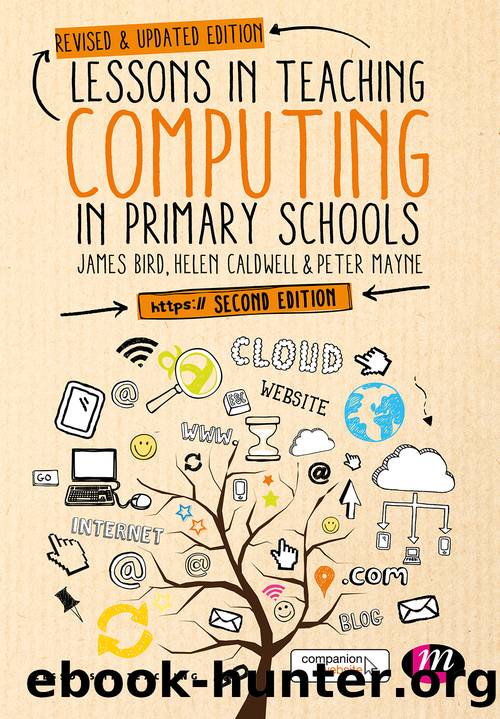Lessons in Teaching Computing in Primary Schools by Bird James;Caldwell Helen;Mayne Peter; & Helen Caldwell & Peter Mayne

Author:Bird, James;Caldwell, Helen;Mayne, Peter; & Helen Caldwell & Peter Mayne
Language: eng
Format: epub
Publisher: SAGE Publications, Limited
Published: 2020-10-08T19:49:04.791093+00:00
Taking it further
We have had a more detailed look at a lesson plan for just one area of the Programme of Study which looks at developing understanding of computer networks. Before this lesson it would be good to get children to have an overall understanding of how familiar computers at home or school communicate with other networks.
A Prezi discussion on the computing planning site http://code-it.co.uk/csplanning.html gives an ideal simplified overview of networks, routers and internet service providers. Children could then be asked to draw a pictorial/symbolic overview of the computer networks they use; this would only require large paper, coloured pens/pencils and possibly sticky notes. This task works particularly well in pairs or threes, where children can draw multiple networks, ideally with different ISPs. During this session it would also be good to show children the schematic map of a representation of internet links, available at http://internet-map.net.
Following the main lesson of focus in this chapter, it would be interesting to quickly revisit childrenâs ideas about how we send and receive messages using the internet. Ideally, the physical or digital posters that they created in the plenary could be displayed after the lesson. Children could then revisit these, and this would present an opportunity for further discussion.
After gaining some basic knowledge and understanding of network infrastructure, children could then develop understanding of finding the location of websites and servers across the world. There are a number of websites that convert web addresses into IP addresses, such as www.getip.com. There are also a number of other websites that can find out the location of IP addresses.
Children could also develop understanding of hypertext markup language (HTML). This would allow them to understand the need for a common language for web pages to work across the internet. There are a number of engaging free resources online, such as Mozilla Thimble (https://thimble.webmaker.org) or Webmaker (https://webmaker.org/en-US). These could be used for classroom activities for pupils to gain basic understanding of web conventions and standardisation.
Download
This site does not store any files on its server. We only index and link to content provided by other sites. Please contact the content providers to delete copyright contents if any and email us, we'll remove relevant links or contents immediately.
Math and Science Investigations by Sally Anderson(82)
Wrestling with Writing by Nicholas D. Young & Bryan Thors Noonan & Kristen Bonanno-Sotiropoulos(57)
Lessons in Teaching Computing in Primary Schools by Bird James;Caldwell Helen;Mayne Peter; & Helen Caldwell & Peter Mayne(57)
Best Practices of Award-Winning Elementary School Principals by Harris Sandra K.;(52)
Loving Math by Unknown(51)
What If Your ABCs Were Your 123s? by Leslie Minton(45)
The Last Little Book About Big Words by James Roberts (Gentleman Jim)(41)
Provoking Curiosity by Angela Eckhoff(37)
Brain-Friendly Study Strategies, Grades 2-8 by Schwed Amy J.;Melichar-Utter Janice;(31)
Introducing Research in Early Childhood by Bolshaw Polly;Josephidou Jo; & Jo Josephidou(28)
Brain-Compatible Activities for Mathematics, Grades 4-5 by Sousa David A.;(26)
Help! for Teachers of Young Children by Kaltman Gwendolyn S.;(26)
Art in the Early Years by Eglinton Kristen Ali;(24)
Nonfiction Notebooks : Strategies for Informational Writing by Aimee Buckner(21)
Making Music in the Primary School by Beach Nick;Evans Julie;Spruce Gary;(21)
Learning from Head Start by Gilford Sidney W.;(18)
Strategies to Integrate the Arts in Mathematics by Linda Dacey; Lisa Donovan(18)
The Write Mind for Every Classroom by Wirtz Jason;(14)
Mastering Primary Art and Design by Peter Gregory; Claire March; Suzy Tutchell(12)
